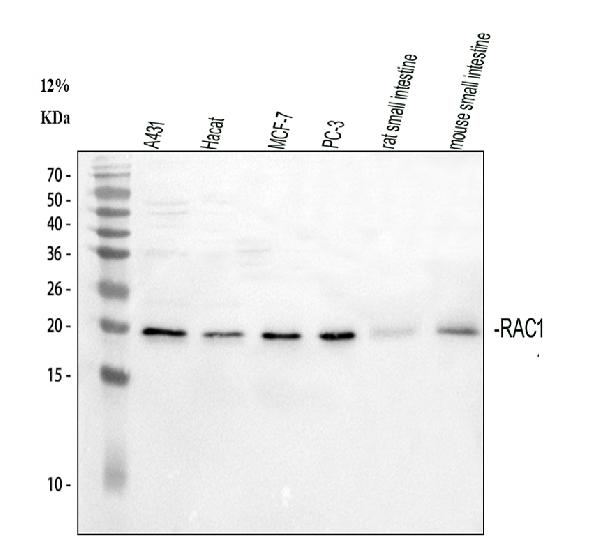
Figure 1. Western blot analysis of Rac1 using anti-Rac1 antibody (PB9431). Electrophoresis was performed on a 5-20% SDS-PAGE gel at 70V (Stacking gel) / 90V (Resolving gel) for 2-3 hours. The sample well of each lane was loaded with 30 ug of sample under reducing conditions. Lane 1: human A431 whole cell lysates, Lane 2: human Hacat whole cell lysates, Lane 3: human MCF-7 whole cell lysates, Lane 4: human PC-3 whole cell lysates, Lane 5: rat small intestine tissue lysates, Lane 6: mouse small intestine tissue lysates. After electrophoresis, proteins were transferred to a nitrocellulose membrane at 150 mA for 50-90 minutes. Blocked the membrane with 5% non-fat milk/TBS for 1.5 hour at RT. The membrane was incubated with rabbit anti-Rac1 antigen affinity purified polyclonal antibody (Catalog # PB9431) at 0.5 microg/mL overnight at 4°C, then washed with TBS-0.1%Tween 3 times with 5 minutes each and probed with a goat anti-rabbit IgG-HRP secondary antibody at a dilution of 1:5000 for 1.5 hour at RT. The signal is developed using an Enhanced Chemiluminescent detection (ECL) kit (Catalog # EK1002) with Tanon 5200 system. A specific band was detected for Rac1 at approximately 21 kDa. The expected band size for Rac1 is at 21 kDa.
Anti-Rac1 Antibody Picoband(r)

PB9431
ApplicationsImmunoFluorescence, Western Blot, ImmunoCytoChemistry
Product group Antibodies
ReactivityHamster, Human, Mouse, Rat
TargetRAC1
Overview
- SupplierBoster Bio
- Product NameAnti-Rac1 Picoband Antibody
- Delivery Days Customer9
- Antibody SpecificityNo cross reactivity with other proteins.
- Application Supplier NoteWB: The detection limit for Rac1 is approximately 0.1ng/lane under reducing conditions. Tested Species: In-house tested species with positive results. Other applications have not been tested. Optimal dilutions should be determined by end users.
- ApplicationsImmunoFluorescence, Western Blot, ImmunoCytoChemistry
- CertificationResearch Use Only
- ClonalityPolyclonal
- Concentration500 ug/ml
- FormulationLyophilized
- Gene ID5879
- Target nameRAC1
- Target descriptionRac family small GTPase 1
- Target synonymscell migration-inducing gene 5 protein; MIG5; MRD48; p21-Rac1; Rac-1; ras-like protein TC25; ras-related C3 botulinum toxin substrate 1; ras-related C3 botulinum toxin substrate 1 (rho family, small GTP binding protein Rac1); TC-25
- HostRabbit
- IsotypeIgG
- Protein IDP63000
- Protein NameRas-related C3 botulinum toxin substrate 1
- Scientific DescriptionBoster Bio Anti-Rac1 Antibody Picoband® catalog # PB9431. Tested in Flow Cytometry, IF, IHC, ICC, WB applications. This antibody reacts with Human, Mouse, Rat. The brand Picoband indicates this is a premium antibody that guarantees superior quality, high affinity, and strong signals with minimal background in Western blot applications. Only our best-performing antibodies are designated as Picoband, ensuring unmatched performance.
- ReactivityHamster, Human, Mouse, Rat
- Storage Instruction-20°C,2°C to 8°C
- UNSPSC12352203
References
- Novel derivative of Paeonol, Paeononlsilatie sodium, alleviates behavioral damage and hippocampal dendritic injury in Alzheimers disease concurrent with cofilin1/phosphorylated-cofilin1 and RAC1/CDC42 alterations in rats. Han F et al., 2017, PLoS OneRead more



